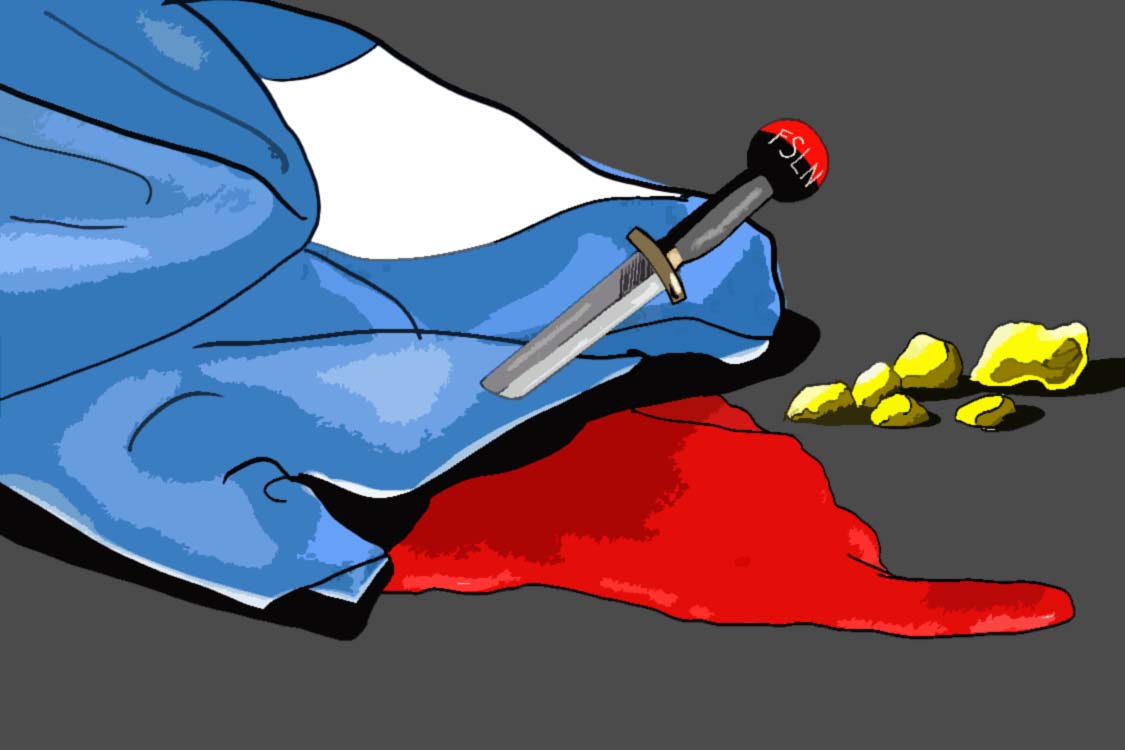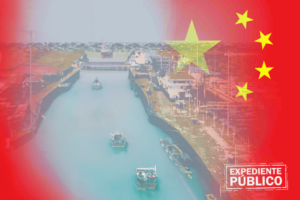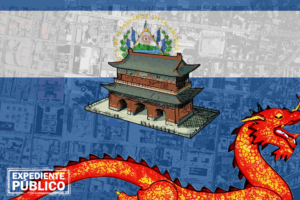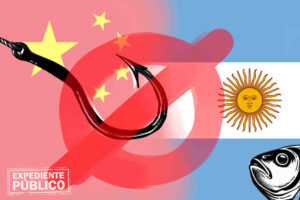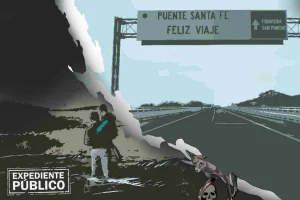*Competition for gold in Northern Caribbean mines brings misfortune to community due to voracity of settlers, companies, municipalities, and the central government.
Expediente Público
In the first semester of 2021, gold became Nicaragua’s most exported product, with sales of $431.1 million USD, according to the Association of Producers and Exporters of Nicaragua (APEN).
Not only did mineral extraction jump 44.6% during the first semester of 2020 but also its value improved by 12.7%, according to APEN. Although there are various gold mines throughout the country, one of the richest areas in gold mining is the Northern Caribbean, particularly the Bosawas Biosphere Reserve and buffer zone.
The Ministry of Energy and Mining (MEM) has granted or renewed at least 21 concessions, each signed for 25 years, distributed between the Bogota-based company HEMCO, CALIBRE MINING (CxB) from Canada, and SANTA RITA MINING from China in the North Caribbean Coast Autonomous Region (RACCN), specifically the three municipalities of Siuna, Rosita, and Bonanza, known as the Golden Triangle of Nicaragua. Most of the licenses were granted in 2010, apart from those awarded in Sisin and Walpa Tara in 2020.
The massacre on August 23 of twelve indigenous people who were attacked while gold mining just 50 kilometers from Bonanza in a place called Kiwakumbaih was carried out by settlers and community members. However, the police assured that the motive was family disputes between ethnic groups, ignoring investigations pointing to land invasions based on the accounts of survivors and human rights organizations. Some of the names and surnames appearing in the investigations are members of the “Chabelo” or Isabel Meneses gang.
Read also: Nicaragua: Policía encubre a colonos y culpa a indígenas por masacre
After hearing the police’s version of the account, the environmentalist Amaru Ruiz pointed out that the national company Exportadora de Metales S.A. (EMSA) works in the area and in the same territory where CALIBRE Mining has requested a license.
EMSA is owned by Edward Irías Pastora, nephew of the Sandinista official Edén Pastora, deceased since 2020 and one of the principal organizers of paramilitaries during the 2018 social protests in Nicaragua.
CALIBRE Mining will also exploit the concession of Borosi (Puerto Cabezas) and La Luz (Siuna); ROSITA Mining will enter the municipality of Rosita, according to the Chamber of Nicaraguan Mintes (CAMINIC).
As of June of 2021, the 10 mines CALIBRE Mining has requested are among the those also solicited by MEM. On MEM’s website, at least 18 projects in the Golden Triangle appear, in addition to the five already established by the company.
For environmentalists and community leaders, the issue for the Northern Caribbean indigenous people with the promotion of extractive activities like mining is that the Nicaraguan government is encouraging the arrival of settlers due to the gold rush in the region.
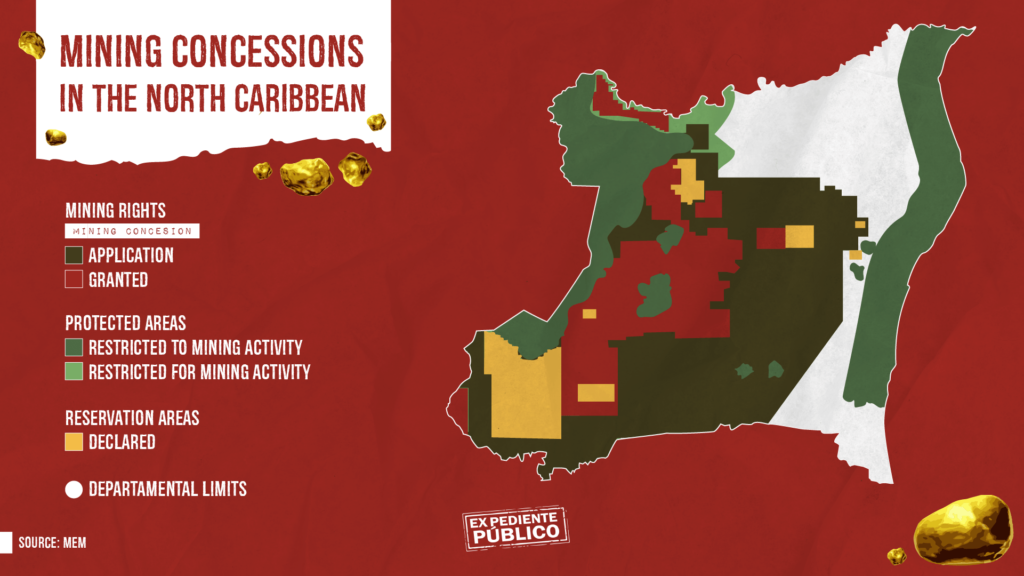
The indigenous people of Nicaragua’s Caribbean: Miskitos, Mayangnas, and Rama and Afro-descendants call land invaders from other regions of the country “settlers”. Since 2010, land seizures have increased, with 2015, 2020, and 2021 being the most violent years.
At least 61 indigenous people have been killed since 2011, product of land conflicts with settlers, according to organizations like the Center for Justice and Human Rights of the Atlantic Cost of Nicaragua (CEJUDHCAN).
The situation is critical because of the loss of almost all farm, fishing, timber, and hunting lands on which indigenous people subsist. According to relatives of the victims of the August 23 massacre who participated in a virtual press conference on September 9, economic desperation motivated several Miskito families to venture to the Kiwakumbaih mine.
Kedelin Jarquín, a young Miskito mother, was one of the twelve victims who left her community for the mine in Mayangna territory to earn some money for her two-year-old and six-month-old, according to her parents Reylis Jarquín Wilson and Ermita Guitérrez Empra.
Wilmor Waldan and Alicia Salgado, the parents of James, another victim of the massacre, said that he also left two children behind “while he searched for the means to feed and educate his family. Our son was not stealing, he was working in the hills where he was killed by settlers and Mayangnas.”
Juan Carlos Ocampo, director of the indigenous organization PRILAKA, explained to Expediente Público that “the expansion of artisanal mining is a consequence of land invasions, as settlers have brought this knowledge with them, and indigenous people are desperate because the forests have been destroyed. There is neither wood to sell nor animals to hunt, compounded with the hurricane crisis. In terms of food security, many are left with no other option but gold mining.”
CAMINIC’s president, Sergio Murillo told the newspaper La Prensa in March of 2021 that the company intended to achieve 12% growth in volume and surpass $750 million USD in gold exports, “which has encouraged investors such as CALIBRE and HEMCO who also have projects that promote the growth of the precious metal’s production.”
Read: Familiares de víctimas piden que investiguen a colonos por la masacre indígena en Bosawás
The Mining Industry: A Ticking Time Bomb
Normally, settlers arrive because of agricultural opportunities, but gold is one of the spoils of adventure which is becoming more and more organized. The leader of PRILAKA, Limbort Bucardo is one of those displaced by the settlers in the areas where gold can be found.
Bucardo comes from the community of Polo Paiwas located on the banks of the Waspúk River, just a few kilometers south of the Coco River at the border with Honduras. The community also borders the Morobilas mine, which since 2008 has pitted indigenous people against settlers and been in the hands of mestizos.
The activist says that his community was attacked by settlers on October 28, 2015, as occurred in various territories that year. The invaders burned every home, which totaled to around 30, and stole livestock. During the attack, a Miskito adolescent died.
Polo Paiwas consists of 12,500 hectares which were granted to former Miskito combatants of the Contra, the anti-Sandinista guerrillas of the 1980s. However, the regional and territorial government rented half of it to a mestizo cooperative without the community’s authorization, causing the present conflict.
“Stories like these are common. Of the 12,500 hectares belonging to this community, 6,500 were negotiated illegally and, as a result, are being occupied,” Bucardo explained to Expediente Público.
Morobilas is a historic Miskito mine that is now in the hands of settlers who extract gold and timber and use the land for cattle ranching, all while the Miskito inhabitants continue living like displaced people, said the indigenous defender.
Bucardo explained that the local municipal authorities have turned their backs on their own communities. The Waspán Mayor’s Office supports the settlers’ request to use indigenous communities and roads to transport their products, so far using trails in the jungle. All of this albeit the indignation and fear of community members who, through threats, blackmail, and setups, are watching their ancestral lands disappear.
“The municipality admits that settlers account for more of their income than indigenous people, making them more appealing,” Bucardo said.
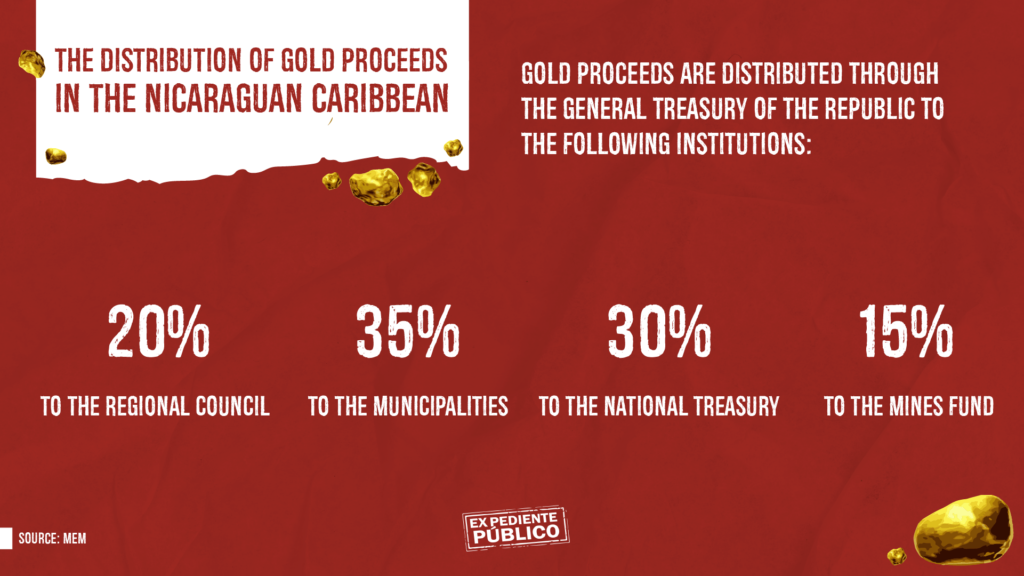
The Mining Chamber of Nicaragua (CAMINIC), which is composed of 49 extractive companies, including eight of which that are focused on metals, “promotes a management and development model for artisanal mining which allows for the transformation of the sector into a business model oriented towards sustainable development.”
CAMINIC’s official digital portal declares that “the model focuses on legal stability and management, the construction of plants exclusive for artisanal mining, training in industrial safety, and environmentally friendly practices.”
The company HEMCO, which has multiple licenses in the Northern Caribbean, explains on its website that it “develops artisanal mining operations under the Bonanza Model or the Management Plan for Artisanal Mining (PODMA). This model was developed in 2012 with the goal to organize, regulate, and ensure the comprehensive development of artisanal mining in the municipality and local communities.”
According to the company, the municipal government, unions, and the Ministry of Energy and Mining (MEM) are driving this program.
HEMCO constructed industrial plants for the exclusive use of artisanal mining by Vesmisa and La Curva, with investments of 6 million USD to process 100 tons of materials per day.
“In 2019, artisanal mining groups working with HEMCO created the Artisanal Mining Production Units (UPMA). The UPMA are zones of exploitation exclusively used by groups, where the owner of the property and the relocated miners assume a series of responsibilities which encourage best practices of artisanal mining.” These zones are located in Tigre Negro and Atlas 650 (Bonanza) and Nueva América (Rosita).
Expediente Público asked HEMCO to explain how its purchase of artisanal gold affects the settler-indigenous conflict, specifically regarding the following dynamics:
- Economic interests in the Northern Caribbean that provoke conflicts over land in indigenous territories, including transnational mining, as pointed out by community members and environmentalists
- The August 2021 massacre in an artisanal mine located in an area close to HEMCO concessions, specifically regarding the position of the company on land invasions, given its interests in mineral exploitation in territories which are mainly community lands
- Purchasing gold from indigenous people or settlers, or competition with these groups in extraction activities, if applicable
- Pending requests to exploit areas where indigenous communities are located, or existing exploitation
- Respect for forests and communal property in these territories
In its response to Expediente Público, the company states, “because of the Bonanza Model, a pioneer strategy in the region, HEMCO promotes safe and responsible mining that considers the environment and communities in its practices. Just in 2021, 2,776 artisanal miners have participated in 75 capacity-building initiatives on the Mining Law, including the topics of first aid, security measures, environmentally responsible mining, and child labor as a prohibited practice, among others.”
“Likewise, [HEMCO] is committed to the wellbeing of its workers, their families, and the community. Thanks to the Management and Urban Development Plan (PODU), HEMCO has contributed to more than 50 projects and social programs on infrastructure, education, health, and sports that provide benefits for everyone,” according to the company.
“From the start of its operations in Nicaragua in 2013, [HEMCO] has been characterized for its compliance with national and international laws, rules, and regulations, which govern the company’s work and respect for human rights in the communities where it has a presence, based on the guiding principles of the United Nations, the Declaration of the International Labor Organization, and the principles of the Global Compact.”
“Under this vision, all Grupo Mineros companies, of which HEMCO is part, have human rights policies that establish the obligation to identify, prevent, limit, and respond to whatever possible negative consequence of the [company’s] activities on human rights, in accordance with existing international norms and agreements signed by each country where [HEMCO] operates,” according to official communication.
In 2017, the total area of the country under mining concessions was 2,600,000 hectares, making more than 20% of Nicaraguan territory under mining concessions, according to the Oakland Institute. The National Nicaraguan Mining Company (ENIMINAS) indicated that 14,980 square kilometers remain available, but CAMINIC states that only 1% of national territory, 120,339 square kilometers of dry land not including 10,033 square kilometers of lakes and lagoons, is not under concession.
Most of Nicaraguan oil exported between January and August of 2021 went to the United States (10,200 kilograms), with a minimum amount shipped to Europe (300 kilograms), according to the Central Bank of Nicaragua.
Read: Indígenas en Nicaragua: conquista y colonización en pleno siglo XXI
The Role of the State-Owned Mining Company ENIMINAS
Ortega named the Treasurer of the Sandinista Front Francisco López as President of ENIMINAS, a position that the head of MEM, Salvador Mansell Castrillo would have held if it were not for his withdrawal prior to international sanctions on corruption charges in 2018.
The public decentralized company was created in 2017 with full capacity to acquire rights and obligations allowing its “association, constitution of mixed companies, and entrance into associations, transitory unions, strategic alliances, and in general, any act or contract permitted by national law, with individuals or corporate bodies, national or foreign entities, and public or private partnerships,” according to Law 953, which founded ENIMINAS.
One of the few operational data available to ENIMINAS can be found in the National Plan for the Fight against Poverty 2022-2026, which includes the 2020 concession of 1,641 hectares in the municipality of Villanueva located in the western part of the country, for the exploration of metal deposits conducted with the Peruvian company Contratistas Generales en Minería (CONGEMIN). Additionally, the Plan mentions the 2018 concession of 2,088 hectares made together with the Canadian company B2Gold, which sold its operations in Nicaragua to CALIBRE Mining in 2019, in the El Santo II Mine in the Chontales province located in the middle part of the country.
In the scarce information provided on its website, ENIMINAS states that [it is] “positioned for an alliance between the artisanal and small-scale mining sector and industry as an axis and emblem of sustainable development in [Nicaragua].”
Moreover, the company’s objectives are to “guide small-scale miners to the most profitable areas for extraction through geologic studies”.
Venezuelan Gold Laundering in Nicaragua?
The American researcher and investigator Douglas Farah pointed out in an April 2021 interview published in the Diario de las Américas that Nicaragua plays a key role in the “laundering” of Venezuelan gold and thus explained the increase in mineral exports for the Central American country.
“What we see is that much of Venezuela’s gold goes to Nicaragua and is exported to the international market as Nicaraguan gold as a way of avoiding sanctions,” explained Farah.
On the other hand, “I believe that what Venezuela has discovered is that, through alliances with Russia, Iran, and China, already sanctioned countries, it can figure out survive. They will not be able to do the same things as before, but they will be able to survive. All of this is tied to Nicaragua. All of these countries are searching for the means to survive sanctions, which imply alliances with new partners and looking for opportunities with Russia and China. Even though currency is not as easy to move in the international market, they avoid the banking systems in the United States and the European Union.”
The four members of the board of directors of the state company are named directly by President Daniel Ortega. One of the board members should represent the private sector, and the board appoints the general manager.
López’s place was occupied by the retired General Ramón Humberto Calderón Vindell, who retired from Petróleos de Nicaragua (PETRONIC) in 2019 following US sanctions on ALBANISA, of which the national oil company was a partner.
Paul Oquist, Secretary of National Policy for the President of the Republic and deceased as of 2021, was part of the board. Salvador Mansell, Minister of Energy and Mining was also on the board. Eduardo Caldera May represented the private sector when it was established, nominated by the Superior Council of Private Enterprise (COSEP), according to statements he made to El Nuevo Diario.
With sanctions against Oquist in 2020, Executive Order 152-2020 named the former head of ALBANISA, Marco Aurelio Rivas Kauffman to the Board of ENIMINAS, as representative of PETRONIC. He is the son of the director of the General Directorate of Revenue, Martín Gustavo Rivas Ruiz, also retired captain from the national police forces.
In December of 2002, Ruy Delgado López, General Manager of ENIMINAS was accused by authorities of trafficking precious wood from the «RP» sawmill located in the Sumubila region and another warehouse in the «Kilómetro Cuarenta y Tres» community in the Northern Caribbean, where mahogany and cedar were found: a total of 70,000 cubic meters not authorized by the National Forestry Institute.
In 2013, he was listed as director for Nicaragua in the Nevada-based company, the Maxam Gold Corporation.
